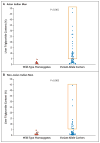Apolipoprotein C3 gene variants in nonalcoholic fatty liver disease
- PMID: 20335584
- PMCID: PMC2976042
- DOI: 10.1056/NEJMoa0907295
Apolipoprotein C3 gene variants in nonalcoholic fatty liver disease
Abstract
Background: Nonalcoholic fatty liver disease is associated with hepatic insulin resistance and type 2 diabetes mellitus. Whether this association has a genetic basis is unknown.
Methods: In 95 healthy Asian Indian men, a group known to have a high prevalence of nonalcoholic fatty liver disease, we genotyped two single-nucleotide polymorphisms (SNPs) in the gene encoding apolipoprotein C3 (APOC3) that are known to be associated with hypertriglyceridemia (rs2854116 [T-455C] and rs2854117 [C-482T]). Plasma apolipoprotein C3 concentrations, insulin sensitivity, and hepatic triglyceride content were measured. We also measured plasma triglyceride concentrations and retinyl fatty acid ester absorption as well as plasma triglyceride clearance after oral and intravenous fat-tolerance tests. Liver triglyceride content and APOC3 genotypes were also assessed in a group of 163 healthy non-Asian Indian men.
Results: Carriers of the APOC3 variant alleles (C-482T, T-455C, or both) had a 30% increase in the fasting plasma apolipoprotein C3 concentration, as compared with the wild-type homozygotes. They also had a 60% increase in the fasting plasma triglyceride concentration, an increase by a factor of approximately two in the plasma triglyceride and retinyl fatty acid ester concentrations after an oral fat-tolerance test, and a 46% reduction in plasma triglyceride clearance. The prevalence of nonalcoholic fatty liver disease was 38% among variant-allele carriers and 0% among wild-type homozygotes (P<0.001). The subjects with nonalcoholic fatty liver disease had marked insulin resistance. A validation study involving non-Asian Indian men confirmed the association between APOC3 variant alleles and nonalcoholic fatty liver disease.
Conclusions: The polymorphisms C-482T and T-455C in APOC3 are associated with nonalcoholic fatty liver disease and insulin resistance.
2010 Massachusetts Medical Society
Figures



Comment in
-
Genetic susceptibility to hepatic steatosis.N Engl J Med. 2010 Mar 25;362(12):1142-3. doi: 10.1056/NEJMe1000206. N Engl J Med. 2010. PMID: 20335592 No abstract available.
-
Apolipoprotein C3 gene variants in nonalcoholic fatty liver disease.N Engl J Med. 2010 Jul 8;363(2):193-4; author reply 195. doi: 10.1056/NEJMc1005265. N Engl J Med. 2010. PMID: 20647217 No abstract available.
-
Apolipoprotein C3 gene variants in nonalcoholic fatty liver disease.N Engl J Med. 2010 Jul 8;363(2):194; author reply 195. N Engl J Med. 2010. PMID: 20653077 No abstract available.
-
Apolipoprotein C3 gene variants in nonalcoholic fatty liver disease.N Engl J Med. 2010 Jul 8;363(2):194-5; author reply 195. N Engl J Med. 2010. PMID: 20653078 No abstract available.
-
Nature vs nurture: genetic susceptibility and weight loss in hepatic steatosis.Clin Genet. 2010 Nov;78(5):422-3. doi: 10.1111/j.1399-0004.2010.01519_3.x. Epub 2010 Aug 26. Clin Genet. 2010. PMID: 20738331 No abstract available.
-
Nonalcoholic fatty liver disease: is it all in the genes?Hepatology. 2010 Nov;52(5):1851-4. doi: 10.1002/hep.24020. Hepatology. 2010. PMID: 21038421 No abstract available.
References
-
- Seppälä-Lindroos A, Vehkavaara S, Häkkinen AM, et al. Fat accumulation in the liver is associated with defects in insulin suppression of glucose production and serum free fatty acids independent of obesity in normal men. J Clin Endocrinol Metab. 2002;87:3023–8. - PubMed
-
- van Dijk KW, Rensen PC, Voshol PJ, Havekes LM. The role and mode of action of apolipoproteins CIII and AV: synergistic actors in triglyceride metabolism? Curr Opin Lipidol. 2004;15:239–46. - PubMed
-
- Olivieri O, Bassi A, Stranieri C, et al. Apolipoprotein C-III, metabolic syndrome, and risk of coronary artery disease. J Lipid Res. 2003;44:2374–81. - PubMed
Publication types
MeSH terms
Substances
Grants and funding
- R01 DK049230/DK/NIDDK NIH HHS/United States
- UL1 RR024139/RR/NCRR NIH HHS/United States
- UL1 RR-024139/RR/NCRR NIH HHS/United States
- P01 DK-068229/DK/NIDDK NIH HHS/United States
- R01 DK040936/DK/NIDDK NIH HHS/United States
- R24 DK085638/DK/NIDDK NIH HHS/United States
- P30 DK045735/DK/NIDDK NIH HHS/United States
- R01 DK-49230/DK/NIDDK NIH HHS/United States
- R01 AG-23686/AG/NIA NIH HHS/United States
- P01 DK068229/DK/NIDDK NIH HHS/United States
- P30 DK-45735/DK/NIDDK NIH HHS/United States
- R01 AG023686/AG/NIA NIH HHS/United States
- HHMI/Howard Hughes Medical Institute/United States
LinkOut - more resources
Full Text Sources
Other Literature Sources
Molecular Biology Databases
Miscellaneous
